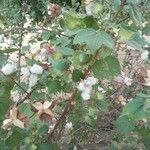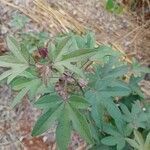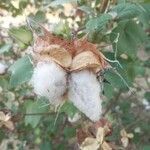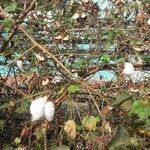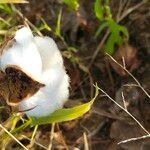Subshrubs or shrubs, perennial, 2-3 m tall. Young branchlets villous. Stipules filiform, caducous; petiole 2-4 cm, puberulent and villous; leaf blade 3-5-lobed, 4-8 cm in diam., lobes oblong-lanceolate, oblong, ovate, or obovate, ca. 1/2 as long as leaf blade, abaxially stellate puberulent, villous along veins, adaxially stellate pilose. Flowers solitary, axillary. Pedicel 1.5-2.5 cm, villous. Epicalyx lobes 3, connate for basal 1/3, ovate-cordate or triangular, ca. 2.5 cm, stellate villous on veins, 3-or 4-toothed, teeth less than 3 × as long as wide. Calyx shallowly cup-shaped, nearly truncate. Corolla yellowish, often dark purple in center, campanulate; petals 3-5 cm. Staminal column 1.5-2 cm; filaments uniform in length. Capsule 3(or 4 or 5)-loculed, cone-shaped, usually pendulous, ca. 3 cm, glabrous, with numerous oily and glandular minute spots, apex tapering, beaked. Seeds 5-8 per cell, free, ovoid, 5-8 mm in diam., with white wool and moderately persistent short fuzz. Fl. Jun-Sep.
More
A shrub. It keeps growing from year to year. It grows to 3 m high. The leaf stalk is 2-4 cm long. The leaves have 5 or 7 lobes and spread out like fingers on a hand. They are shiny above. They are parted for half the length of the leaf. The leaf blade is 4-8 cm across. The flowers occur singly in the axils of leaves. The flowers are yellow or purple. The centre is red. The fruit is a capsule. It is oblong and hangs down. It is 3 cm across. The fruit capsule has 3 valves. There are 5-8 seeds in each cell. They are 5-8 mm across.
Perennial shrubs, or annual subshrubs
Flowers red or purple, or yellow.
